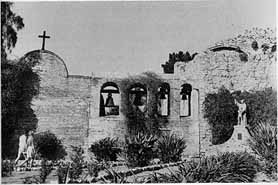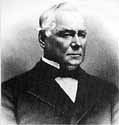Index |
Early (1400-1850) |
Land (1850-1900) |
Early 20th (1900-1950) |
Recent (1950-now) |
Trivia |
Links |
My Favorites |
Bibliography
Orange County History: Pre-1850
Early History
Orange County was first settled by the Native Indians; there were the Gabrieleños
and the Juaneños. The names given to these two groups of Indians comes from the
Missions that they were closest to: Mission San Gabriel and Mission San Juan
Capistrano. They were peaceful people who had great respect for the land. They
rarely fought each other. If they did, however, it was because of family feuds that
might occur. These would be carried on through many generations. These Indians
also had many sacred grounds, one of which is really close to my house: the Bolsa
Chica Mesa. I've heard that the Mesa served as a place where only the high religious
leaders were able to go. From the Mesa, the Indians could see a great view of the
ocean as well as present day Long Beach and the Palos Verdes Peninsula. Regular
lay-people could not go to the Mesa, since it was sacred.
Exploration
Sometime in the 1700's, Gaspar de Portolá was commissioned by the Spanish Crown to
explore and map the California Coast and to find viable trade routes. He entered
Orange County along with Franciscan Monks who hoped to convert the Native Indians.
Their first Baptism, performed by Father Juan Crespi and Father Francisco Gomes, came in the
area near present day San Clemente, where they have an
annual La Christianita Pageant celebration to commemorate this milestone. Portolá
gave many of the names of rivers, mountains, and valleys in honor of Catholic Saints. For example, this party named the Santa Ana
River. Its full name is Río de la Santa Ana de los
Temblores, because there was an earthquake about the time they reached the river. Also,
the foothill regions of South County (around El Toro, etc.) was originally given a Christian name, but it was nicknamed Trabuco because a soldier had lost his
Trabuco (blunderbuss in Spanish, I think meaning some sort of gun) there. The road they traveled
on later became known as El Camino Real. Today, El Camino Real still exists, and is
mostly replaced by Interstate 5 for most of the county. The party continued on to Los
Angeles County and later to end up in Monterey (even though they missed it and reached
the San Francisco Bay, but they got there eventually).
The Mission Era
Among the people who accompanied Portolá was Father Junipero Serra. He looked for good
sites on which he could build missions to work the land and convert the Indians. He
did see a good site on the San Juan River, and in 1776, with the founding of the
United States, he founded Mission San Juan Capistrano. Father Serra built the mission twice; the first time it was
abandoned because of word of an Indian uprising. The fathers buried the church bell and returned
to the Presidio in San Diego to take refuge. They came back in 1776 to rebuild the mission.
 Father Serra named Mission San Juan Capistrano
after an Italian Saint whom he admired greatly. The
mission was a great center for activity: there were thousands of Indians working the
land. Few Indians converted to Christianity, however, but eventually they did because
the Spanish government said that Indians could own land if they converted. However,
with the independence of Mexico in the 1820's,
Father Serra named Mission San Juan Capistrano
after an Italian Saint whom he admired greatly. The
mission was a great center for activity: there were thousands of Indians working the
land. Few Indians converted to Christianity, however, but eventually they did because
the Spanish government said that Indians could own land if they converted. However,
with the independence of Mexico in the 1820's,
 that proclamation was also gone. The new Mexican
Government was not as supportive of the Missions as the Spanish were, and the Indians were
forced to leave the Missions and work the land. Before the Spanish left, however, they
divided the land into many subdivisions, known as Ranchos. Most of the Indians were
not granted land ownership. The ownership was parceled out by way of Spanish and
Mexican Land Grants. Among the landowners at that time were the Yorba family, the
Peralta family, as well as John Forster. Forster married the sister of the last
Mexican Governor, Pio Pico, and was able to acquire large parcels of land in South
County. By the close of the Mexican rule of Alta California, the Missions were in a
state of disrepair, abandoned. For a while, John Forster used Mission San Juan
Capistrano as his home.
that proclamation was also gone. The new Mexican
Government was not as supportive of the Missions as the Spanish were, and the Indians were
forced to leave the Missions and work the land. Before the Spanish left, however, they
divided the land into many subdivisions, known as Ranchos. Most of the Indians were
not granted land ownership. The ownership was parceled out by way of Spanish and
Mexican Land Grants. Among the landowners at that time were the Yorba family, the
Peralta family, as well as John Forster. Forster married the sister of the last
Mexican Governor, Pio Pico, and was able to acquire large parcels of land in South
County. By the close of the Mexican rule of Alta California, the Missions were in a
state of disrepair, abandoned. For a while, John Forster used Mission San Juan
Capistrano as his home.
Created by Kenneth Kao.
 Father Serra named Mission San Juan Capistrano
after an Italian Saint whom he admired greatly. The
mission was a great center for activity: there were thousands of Indians working the
land. Few Indians converted to Christianity, however, but eventually they did because
the Spanish government said that Indians could own land if they converted. However,
with the independence of Mexico in the 1820's,
Father Serra named Mission San Juan Capistrano
after an Italian Saint whom he admired greatly. The
mission was a great center for activity: there were thousands of Indians working the
land. Few Indians converted to Christianity, however, but eventually they did because
the Spanish government said that Indians could own land if they converted. However,
with the independence of Mexico in the 1820's,
 that proclamation was also gone. The new Mexican
Government was not as supportive of the Missions as the Spanish were, and the Indians were
forced to leave the Missions and work the land. Before the Spanish left, however, they
divided the land into many subdivisions, known as Ranchos. Most of the Indians were
not granted land ownership. The ownership was parceled out by way of Spanish and
Mexican Land Grants. Among the landowners at that time were the Yorba family, the
Peralta family, as well as John Forster. Forster married the sister of the last
Mexican Governor, Pio Pico, and was able to acquire large parcels of land in South
County. By the close of the Mexican rule of Alta California, the Missions were in a
state of disrepair, abandoned. For a while, John Forster used Mission San Juan
Capistrano as his home.
that proclamation was also gone. The new Mexican
Government was not as supportive of the Missions as the Spanish were, and the Indians were
forced to leave the Missions and work the land. Before the Spanish left, however, they
divided the land into many subdivisions, known as Ranchos. Most of the Indians were
not granted land ownership. The ownership was parceled out by way of Spanish and
Mexican Land Grants. Among the landowners at that time were the Yorba family, the
Peralta family, as well as John Forster. Forster married the sister of the last
Mexican Governor, Pio Pico, and was able to acquire large parcels of land in South
County. By the close of the Mexican rule of Alta California, the Missions were in a
state of disrepair, abandoned. For a while, John Forster used Mission San Juan
Capistrano as his home.